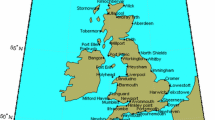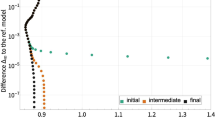Abstract
Tidal types (semi-diurnal, diurnal, and mixed tides) have been determined based on the ratio of amplitudes between four major tidal constituents (M2, S2, K1 and O1) obtained via harmonic analysis. However, this traditional method has rarely been reevaluated and could be inaccurate especially when the total contribution of the four major tidal constituents is relatively low in a region. In this study, an alternative method was suggested to classify tidal types based on auto-correlation analysis by adopting the classification criteria values of tidal form number, and replacing harmonic analysis with the auto-correlation method. Sea level height data from 186 tide gauges for 10 years provided by the University of Hawaii Sea Level Center were analyzed. The average difference between the result obtained from a traditional harmonic analysis and that obtained from the new auto-correlation analysis method is 16.12% for 10 years. The difference is lower in areas with a large tidal range, but higher where the total contribution of the four major tidal constituents is low. These results were confirmed by comparison with the gridded TPXO model data. The new auto-correlation analysis developed in this study can be used as an alternative to the traditional harmonic analysis method where the total contribution of the four major tidal constituents is low.
Similar content being viewed by others
References
Amin M. (1986) On the conditions for classification of tides. Int J Hydrog Rev 13(1):161–pp174
Byun D-S (2011) Investigation the adjustment methods of monthly variability in tidal current harmonic constants. Ocean Polar Res 33(3):309–pp319
Courtier A. (1938) Marees. Service hydrographique de la Marine, Paris, 284 p
Darwin G. (1883) On the harmonic analysis of tidal observations of high and low water. P Roy Soc 48:278–pp340
Defant A. (1961) Physical oceanography. Pergamon Press, Oxford, 598 p
Egbert GD, Bennett AF, Foreman MGG. (1994) TOPEX/Poseidon tides estimated using a global inverse model. J Geophys Res 99:821–pp824
Egbert GD, Erofeeva SY. (2002) Efficient inverse modeling of barotropic ocean tides. J Atmos Ocean Tec 19:183–pp204
Gill SK, Schultz JR. (2001) Tidal datums and their application: NOAA special publication Nos Co-Ops 1. National Oceanic and Atmospheric Administration, Silver Spring, 136 p
LeBlond PH. (1966) On tidal propagation in shallow rivers. J Geophys Res 83:4717–pp4721
Parker BB. (1991) The relative importance of the various nonlinear mechanism in a wide range of tidal interactions. In: Parker BB (ed) Tidal hydrodynamics. Wiley, New York, pp 237–268
Pugh DT. (1987) Tides, surges and mean sea-level: a handbook for engineers and scientists. Wiley, Chichester, 472 p
Schureman P. (1940) Manual of harmonic analysis and prediction of tides. US Department of Commerce, Coast and Geodetic Survey, Washington DC, 317 p
Acknowledgements
The author acknowledges the UHSLC for providing public access to the archived data used in this study. The authors also sincerely thank anonymous reviewers for their helpful comments. This work is supported by a research grant provided by Chungcheong Sea Grant Program, and a basic research program (NRF-2016R1D1A1B03931519) funded by National Research Foundation of Korea.
Author information
Authors and Affiliations
Corresponding author
Rights and permissions
About this article
Cite this article
Lee, SH., Chang, YS. Classification of the Global Tidal Types Based on Auto-correlation Analysis. Ocean Sci. J. 54, 279–286 (2019). https://doi.org/10.1007/s12601-019-0009-7
Received:
Revised:
Accepted:
Published:
Issue Date:
DOI: https://doi.org/10.1007/s12601-019-0009-7




